Metropolitan line
The Metropolitan Line is a London Underground line connecting Aldgate in the City of London with Amersham; branch lines run to Chesham, Uxbridge and Watford. It is 66.7 km long and serves 34 stations in Greater London, as well as regions adjacent to it to the northwest. It shares the section between Aldgate and Baker Street with the Circle Line, the section between Rayners Lane and Uxbridge with the Piccadilly Line and the section between Harrow and Amersham with Chiltern Railways. Apart from the Central Line, the Metropolitan Line is the only underground line that crosses the border of Greater London.
In 1863 the Metropolitan Railway started the world's first underground railway between Paddington and Farringdon. The most important line was the one northwest of Baker Street into the rural areas of Middlesex, Hertfordshire and Buckinghamshire. The sections near the city centre were electrified by 1907, but beyond Harrow trains hauled by steam locomotives continued to operate until 1961. After the Metropolitan Railway was absorbed into the London Passenger Transport Board in 1933, the line was gradually shortened. Since 1990, the line between Hammersmith and Barking, which previously belonged to the Metropolitan Line, has been run independently as the Hammersmith & City Line.
Between Aldgate and Finchley Road, the line is constructed as an under-pavement railway and thus runs directly below the ground surface. Nine of 34 stations are underground. The majority of the line is dual carriageway, with the exception of the single carriageway branch to Chesham and a four carriageway section between Wembley Park and Moor Park. The section between Wembley Park and Finchley Road is also four-lane; however, the inner tracks there are used by the Jubilee Line (since 1979; from 1939 to 1979 by the Bakerloo Line).
The branch line to Watford will be diverted to Watford Junction via the Croxley Rail Link in the near future. Construction work is due to start in 2016 and be completed in 2020.
History
metropolitan railway
→ Main article: Metropolitan Railway
The Metropolitan Railway (also known as the Met), was a railway company that provided passenger and freight services in London and the north-western suburbs from 1863 to 1933. After years of lobbying by the lawyer Charles Pearson, construction began on the first line in May 1860. This connected the stations of Paddington, Euston and King's Cross with the City of London. Between Paddington and King's Cross it was built in open construction under the New Road, then to Farringdon in cuttings and a short tunnel. It opened on 10 January 1863, with trains composed of steam locomotives and wooden carriages. This section is generally regarded as the oldest underground railway in the world.
For the first six years the line was equipped with both standard gauge and broad gauge tracks. Trains of the Great Western Railway initially ran on the latter. The cooperation ended after six months due to considerable differences of opinion. The Met then had to hire rolling stock from the Great Northern Railway until the first order of its own was delivered. Between 1865 and 1871, the so-called Widened Lines were built east of King's Cross to provide access to the City of London for other railway companies in parallel with the Metropolitan Railway. Soon the railway was extended at both ends and northwards from Baker Street. The Met reached Hammersmith in 1864 and Richmond in 1877.
A parliamentary commission recommended that the Met's trunk line be extended at both ends, creating a ring line. A second company, the District Railway, was formed to provide funding for the southern half of the ring. With the completion of the section between Mansion House and Aldgate in 1884, including a branch to Whitechapel, the Inner Circle around the city centre was completed after twenty years. It had originally been intended to merge the District with the Met. However, relations increasingly deteriorated under the leadership of Edward Watkin and the District remained independent. Both companies ran the entire ring road and competed fiercely with each other. The most important route developed into that to the north-west into rural Middlesex, where it stimulated the development of several new suburbs. Harrow was reached in 1880 and finally in 1899 the line reached as far as Verney Junction, situated to the north-east of Oxford and more than 50 miles from Baker Street. From the late 19th century the Metropolitan Railway shared tracks with the Great Central Railway.
The introduction of competing tubular railways led to a marked decline in passenger numbers in central London. The Met and District responded by setting up an electric trial service between Earl's Court and High Street Kensington in 1900. As a result of these trials, a joint committee of both companies decided to operate with alternating current and overhead wires. However, when the Underground Electric Railways Company of London (UERL) took over the District Railway, there were disagreements. The UERL was led by Charles Tyson Yerkes who, based on his experience in the USA, preferred a direct current system with conductor rail. After a conciliation hearing, both societies agreed on this system. In 1905/06 electrification of the network near the centre and of the line from Baker Street via Harrow to Uxbridge took place.
Unlike other British railway companies, the Met developed land along its lines for the construction of housing estates, which allowed it to profit directly from the resulting increase in value. After the First World War, it conducted targeted advertising campaigns for this purpose under the brand name Metro-land. In this way it encouraged the development of new suburbs. Two new branch lines to Watford and Stanmore, opened in 1925 and 1932, were electrified from the start, while steam trains continued to run on the sections northwest of Rickmansworth.
London Underground
On 1 July 1933, the Metropolitan Railway merged with other underground, tram and bus companies in the London Passenger Transport Board (LPTB), which operated under the brand name London Transport. The Met's network became the Metropolitan Line of London Underground. The LPTB wanted to concentrate on passenger services and was not interested in freight. It stopped carrying parcels on 2 July 1934 and closed the goods shed at Vine Street (near Farringdon station) on 30 June 1936. On 1 November 1937 the London and North Eastern Railway (LNER) took over all freight services. On the same date, the LNER took over the operation of passenger trains with steam locomotives north-west of Rickmansworth. The last train on the branch line to Brill ran on 30 November 1935, and between Aylesbury and Verney Junction services ceased on 2 April 1936. From 1943 to 1948 the Metropolitan Line temporarily resumed running the section between Aylesbury and Quainton Road.
The District Line was overloaded east of Whitechapel, so some Metropolitan trains continued to Barking from 1936. Initially these were 6-car trains from the Hammersmith & City Line, diverted from the East London Line. Then from 1939 it was 6-car trains from Uxbridge continuing east from Aldgate. However, this caused operational problems, so from 1941 Barking was again served by trains from Hammersmith. Through trains to the East London Line via St Mary's curve were discontinued in November 1939. The Great Northern & City Railway between Moorgate and Finsbury Park, isolated from the rest of the network, which had been taken over from the Metropolitan Railway in 1913, was given the name Northern City Line and was operationally part of the Northern Line from 1937.
The New Works Programme, adopted in 1935, triggered extensive building work, including the rebuilding of Rayners Lane, Eastcote, Ruislip Manor and Uxbridge stations. A bottleneck still existed at Finchley Road where the four track line narrowed to two tracks towards Baker Street. The LPTB decided to run the Bakerloo Line through new parallel tunnels; likewise it was to serve the intermediate stations there and take over the branch line to Stanmore. Three existing Metropolitan Line stations were replaced by two new Bakerloo Line stations. Platform alterations were required between Wembley Park and Finchley Road, and the junction at Wembley Park was rebuilt as a flyover structure. Work began in April 1936 and on 2 November 1939 the Bakerloo Line made its first run to Stanmore. There was an intention to extend Harrow station from four to six tracks, which would have given the LNER its own platform there, but the outbreak of the Second World War interrupted the work.
In the 1930s, the complete new construction of the section between Wembley Park and Amersham was also planned, but this was delayed by more than two decades and could only be carried out between 1956 and 1962. The four-lane section now extended to Moor Park. This was accompanied by electrification between Rickmansworth and Amersham and on the branch line to Chesham on 12 September 1960. The last steam locomotive hauled underground train ran on 9 September 1961, and the following day British Rail took over operation on the last non-electrified section between Amersham and Aylesbury, using diesel multiple units. A single four-car commuter train ran on the Chesham branch line. The introduction of single-car operation was first proposed for this in 1972, but was delayed until 1986 due to disputes with trade unions.
Although the East London Line had been operated in isolation by commuter trains since 1939, it was shown on line network maps as part of the Metropolitan Line until 1968. The train run between Hammersmith and Whitechapel (during rush hour to Barking), also formerly operated as part of the Metropolitan Line, has been designated as the Hammersmith & City Line and operated independently since 1990. Since then, the Metropolitan Line has been limited to the Aldgate - Baker Street route and the north-west connecting routes to Amersham, Chesham, Uxbridge and Watford.
In 2003, the infrastructure was partially privatised under a public-private partnership and transferred to the Metronet consortium. Metronet went bankrupt in 2007, after which Transport forLondon (TfL) took over responsibility for maintenance. In 2010 TfL reduced the number of trains to Amersham to two per hour and at the same time introduced direct trains from Chesham to London, replacing the previous shuttle trains.
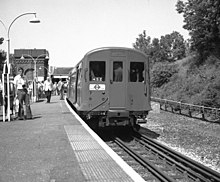
Chesham Station (1977)
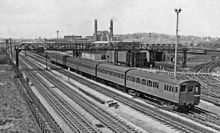
Neasden depot (1959)
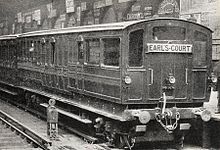
Electric experimental train (1900)
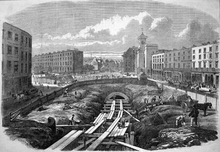
Construction of the Metropolitan Railway near King's Cross, 1861
Track
The Metropolitan Line is 66.7 kilometres long and serves 34 stations. It is electrified with a direct current system, consisting of a busbar in the middle of the route at -210 V and another side busbar at +420 V, giving a potential difference of 630 V. The first 9.7km between Aldgate and Finchley Road is underground, with the section up to Baker Street shared with the Circle Line and Hammersmith & City Line. Between Finchley Road and Wembley Park the line runs parallel to the Jubilee Line (directional tracks arranged in pairs), with interchanges at the same platform at the stations mentioned. At Wembley Park the Jubilee Line branches off towards Stanmore by means of an overbridge. From Finchley Road the four tracks run parallel to the Chiltern Main Line coming from Marylebone.
Between Wembley Park and Harrow-on-the-Hill the Metropolitan Line continues to be four-track, also with directional tracks in pairs, parallel to the double-tracked and non-electrified Chiltern Main Line. The local tracks are located between the express tracks and the two intermediate stations have centre platforms. Harrow-on-the-Hill has platforms for all lines. Here the 12.1km branch line to Uxbridge branches off at grade; after Rayners Lane it shares this with the Piccadilly Line.
The main line is also four-tracked between Harrow-on-the-Hill and Moor Park, and paired by use. The western express tracks are shared with Chiltern trains from Marylebone, and the eastern local tracks have side platforms at intermediate stations. West of Moor Park follows the Watford Triangle track triangle, where the double track branch line to Watford branches off. Between the Watford Triangle and Amersham the main line is double tracked. A 6.26 kilometre single track branch line to Chesham begins at Chalfont & Latimer. The Metropolitan Line terminates at Amersham, where there are shunting tracks immediately after the platforms. The remainder of the line to Aylesbury is reserved for ChilternRailways trains.
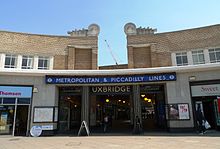
Uxbridge Station
Search within the encyclopedia